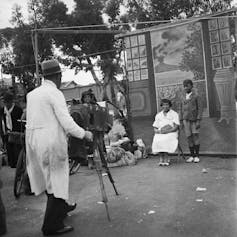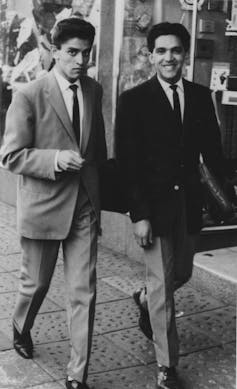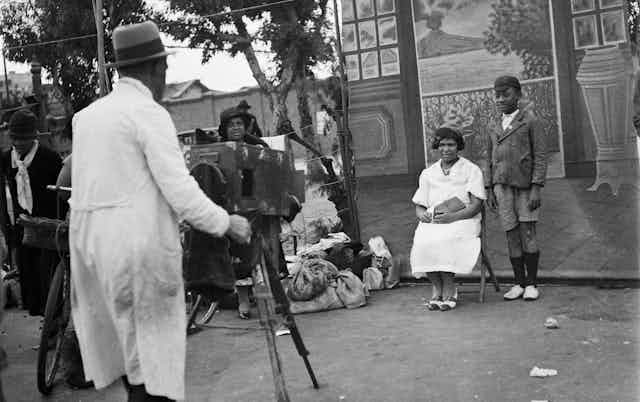In 1937, Anne Fischer, a young Jewish refugee, fled Nazi persecution and travelled via Palestine, Italy, Greece and England to South Africa. There she established herself as a photographer.
She set up a portrait studio on Adderley Street in central Cape Town and, by the 1960s, had become the portrait photographer of choice for wealthy families in the city. In addition to documenting celebrations, weddings and the arrival of new babies, Fischer served as the official photographer for several theatre companies. She also produced a large number of images outside of her studio. These were taken in the streets of Cape Town, in Langa township, in the vibrant multi-racial neighbourhood of District Six, which the apartheid state declared a “whites-only” area in 1966, forcing 60,000 people from their homes, and on her travels around the country.
Fischer’s image of a photographer at work outdoors in Cape Town in the 1940s is unusual because it captures both the making of a portrait and the social world that swirls around the sitters that studio portraits so often conceal from view.
A studio on the street
The painted backdrop shows large windows opening onto a balcony with an ornate railing and the sea beyond. Across the water is a volcano with lava and smoke billowing – possibly a depiction of Mt Vesuvius, which erupted in 1944. Seated before it is a woman holding a small handbag on her lap, her feet perfectly positioned. Her white clothing looks all the more immaculate when it is compared to the soiled fabric of the photographer’s coat.
At her side is a young boy who also seems to be dressed in his Sunday best, but his shorts and socks are misaligned, adding a touching and comical element to the composition, which has an overall cheerful air to it. Part of the beauty of the image is that it does not silence the background noise that accompanied its production.

Instead the photograph contains the elaborate rigging that holds up the backdrop – the trees, wall and roof of a house that are the ‘real’ background. There are packages and bundles of belongings on the ground, a bicycle, two people passing, and a woman who might be next in line to be photographed. Even the photographer and his huge camera on legs appear within the frame. With his one foot lifted in the air, he looks as if he might be about to begin a dance with the waiting woman, whose body seems to be formed by the camera, her head visible above and her one foot below.
Fischer’s photograph also opens a window into the hidden history of street photography in South Africa. In the catalogue to an exhibition he curated, The Other Camera, photographer Paul Weinberg observes that although many of those who made a living from photography under apartheid did not have the means to set up their own studios and instead plied their trade on the street, their work remains largely unrecognised. He also points out:
Many established Black photographers in South Africa began their careers as street photographers, notably, Ernest Cole, Santu Mofokeng, Juda Ngwenya … and William Matlala.
An emerging history
Research on the history of street photography is just starting to emerge. Portraits by the iconic street photography studio Movie Snaps, which operated from a pavement on the edge of the Grand Parade in Cape Town, form the basis for a research project, exhibition and short film curated by academic and filmmaker Siona O’Connell in 2015.
Historian Phindi Mnyaka has written about the work of Daniel Morolong, who began his career as a street photographer. He established the Morolex Ideal Studios in 1968 in Mdantsane near East London, a city on the country’s Eastern Cape coast. He photographed urban Black people in their homes, at significant events and at leisure, often relaxing on the beaches that would a short time later be racially segregated. The building that housed Morolong’s studio was razed in a fire during the 1990 coup in the Ciskei, one of the so-called ‘homelands’ set up by the apartheid state. Almost all of Morolong’s equipment and negatives were destroyed.

An incongruous image
Images taken by street photographers under apartheid can be understood as instances of what academics Marianne Hirsch and Leo Spitzer have termed “incongruous images”. These photographs “seem to refuse to testify to the alarming context in which they were taken”.
A portrait by a street photographer of anti-apartheid activist Ahmed Timol walking alongside his friend Suliman Sujee is exemplary in this regard. This photograph shows us something of what it meant to occupy public space as a person categorised by the apartheid state as “Indian”, and therefore as a potential target for state-sanctioned violence. But it does not show us what we expect to see when we look at images of violence.
Read more: Reframing women in Namibia's early history of photography
Because of this, the photograph instructs us to look more carefully. To consider whether these young men are dressed so immaculately because, in the context in which they find themselves, it is necessary for them to assert their dignity, to dress so sharply that it is an affront to those who think themselves superior in every way. It’s a small yet not so subtle assertion of their worldliness, of their claim to belonging, that exceeds the narrow confines of racist, retrogressive 1960s South Africa. The photograph was made not long before Timol was tortured and murdered by the security police, the 22nd person to die in detention.
These kinds of photographs are reminders of untold histories that are only now being unearthed, and they cast light not only on how people were seen in the violent glare of apartheid, but also on how they chose to see themselves.

